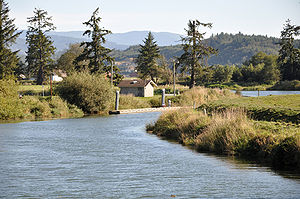| Trask River | |
|---|---|
 Trask River from Oregon Route 131 bridge at Tillamook | |
| Location | |
| Country | United States |
| State | Oregon |
| County | Tillamook County |
| Physical characteristics | |
| Source | Northern Oregon Coast Range |
| • location | Tillamook State Forest, East of Tillamook |
| • coordinates | 45°26′23″N 123°36′41″W / 45.43972°N 123.61139°W[1] |
| • elevation | 281 ft (86 m)[2] |
| Mouth | Tillamook Bay |
• location | Oregon |
• coordinates | 45°28′13″N 123°52′57″W / 45.470381°N 123.882627°W[1] |
• elevation | 3 ft (0.91 m)[1] |
| Length | 18 mi (29 km)[3] |
| Basin size | 175 sq mi (450 km2)[4] |
| Discharge | |
| • location | 10.95 miles (17.62 km) from the mouth[5] |
| • average | 989 cu ft/s (28.0 m3/s)[5] |
| • minimum | 49 cu ft/s (1.4 m3/s) |
| • maximum | 25,800 cu ft/s (730 m3/s) |
The Trask River is in northwestern Oregon in the United States. It drains a mountainous timber-producing area of the Northern Oregon Coast Range west of Portland into Tillamook Bay and the Pacific Ocean.[3][6] It is one of five rivers—the Tillamook, the Trask, the Wilson, the Kilchis, and the Miami—that flow into the bay.[7]
The main stem of the river is 18 miles (29 km) long from where its two forks join at 45°26′23″N 123°36′41″W / 45.439830°N 123.611505°W. The North Fork, 30 miles (48 km) long, rises in several forks itself in the Tillamook State Forest in western Washington County, west of Forest Grove, Oregon. It flows generally west into eastern Tillamook County. The South Fork, 10 miles (16 km) long, rises in southern Tillamook County at 45°20′56″N 123°39′12″W / 45.3489972°N 123.6534486°W and flows generally northward.
The river is known for its runs of Steelhead and Chinook salmon.
The river is named for Elbridge Trask who settled on the shores of Tillamook Bay in 1848. Trask's overland journey was described in the 1960 historical novel Trask by Don Berry, as well as two sequels. The novels are collectively known as the "Trask novels."
- ^ a b c "Trask River". Geographic Names Information System (GNIS). United States Geological Survey. November 28, 1980. Retrieved November 19, 2009.
- ^ Source elevation derived from Google Earth search using GNIS source coordinates.
- ^ a b United States Geological Survey. "United States Geological Survey Topographic Map: Trask, The Peninsula, and Tillamook quadrants". TopoQuest. Retrieved November 19, 2009. The maps include river-mile markers from mouth to source.
- ^ "Trask River Basin". Tillamook Bay Watershed Council. Archived from the original on August 28, 2008. Retrieved November 19, 2009.
- ^ a b Cite error: The named reference
dischargewas invoked but never defined (see the help page). - ^ Oregon Atlas and Gazetteer (Map) (2008 ed.). DeLorme Mapping. § 26–27. ISBN 978-0-89933-347-2.
- ^ "Five Rivers". Tillamook Bay Watershed Council. Archived from the original on August 7, 2008. Retrieved November 14, 2009.
